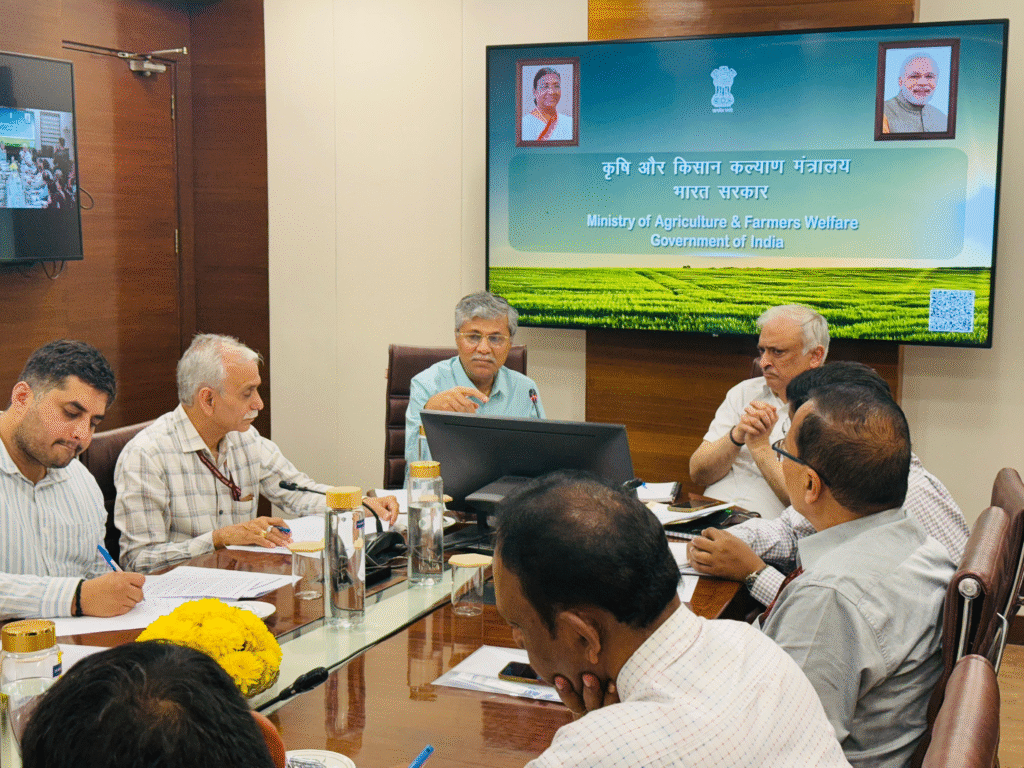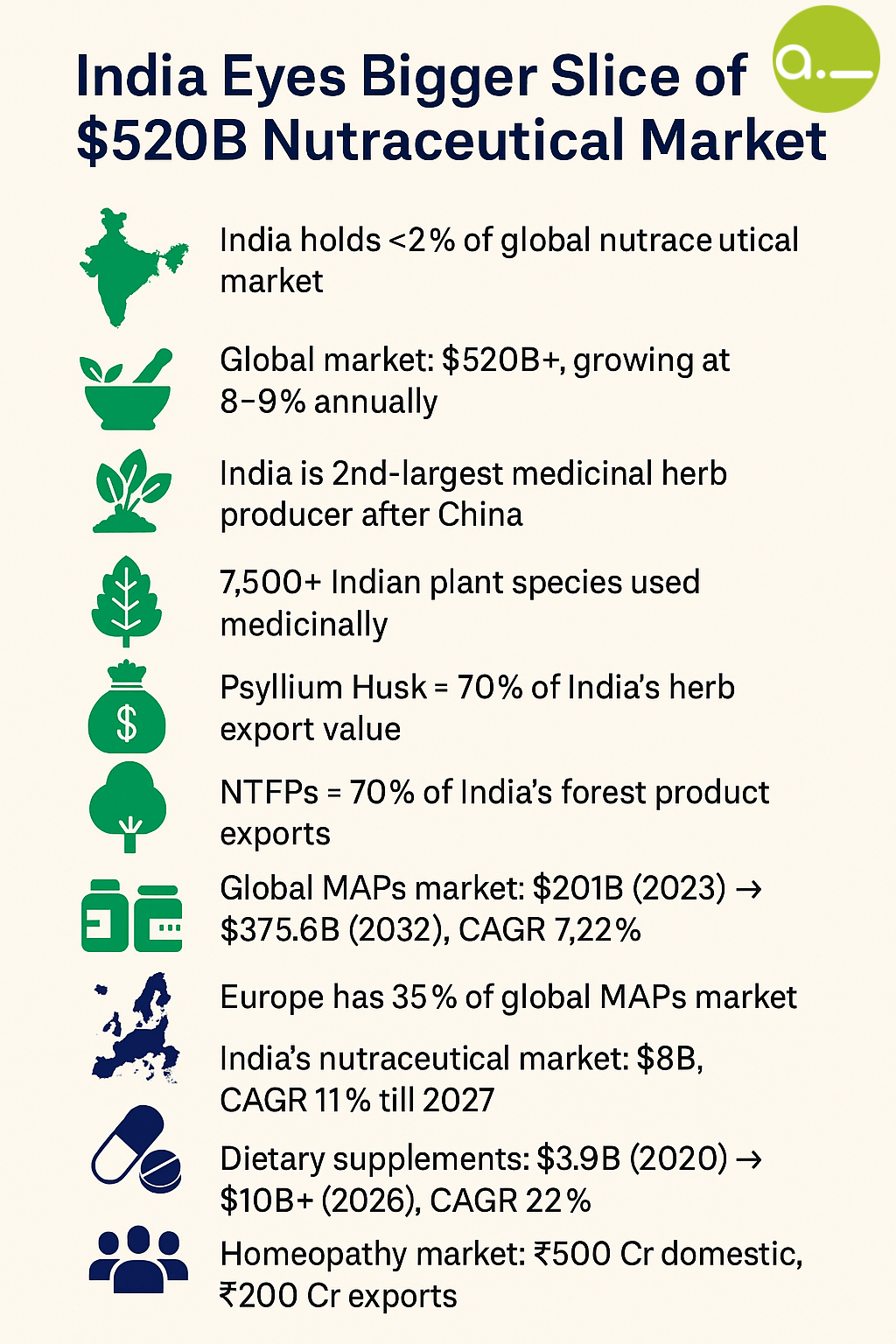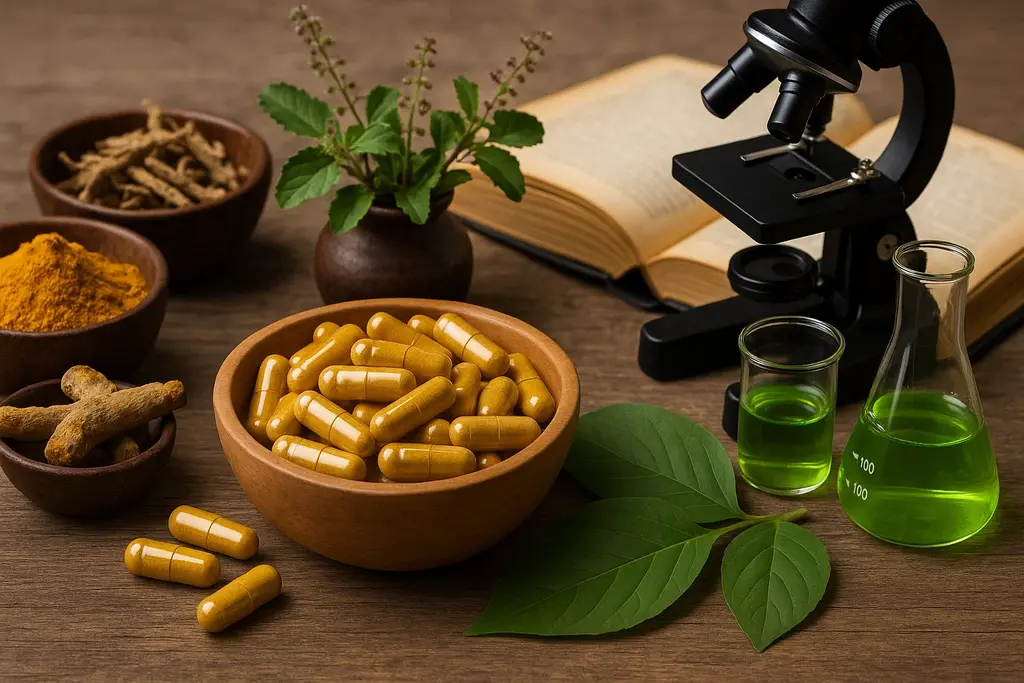The term “nutraceutical” is derived from “nutrition” and “pharmaceutical”—and it refers to products derived from food sources that offer additional health benefits beyond basic nutrition. These can include dietary supplements, fortified foods, functional beverages, and herbal products, all designed to improve health, delay aging, prevent chronic diseases, or support the structure or function of the body.
Globally, the growing burden of lifestyle-related diseases—such as obesity, diabetes, cardiovascular disorders, and micronutrient deficiencies—has driven increased interest in nutraceuticals as preventive, non-invasive solutions. Consumers are increasingly shifting from reactive medical treatments to proactive wellness strategies, giving rise to a booming global market worth over $520 billion.
In India, the relevance of nutraceuticals is uniquely significant. With its deep roots in Ayurveda and access to a wide range of medicinal plants, India has a dual advantage of traditional knowledge and biological diversity. The country faces a dual burden of malnutrition and rising lifestyle diseases, making affordable, accessible health supplements a public health imperative. This convergence of need and heritage places India in a prime position to contribute both scientifically and economically to the global nutraceutical conversation.
India’s nutraceutical boom is not only rooted in traditional knowledge systems like Ayurveda, but also increasingly powered by agrotechnology or agrotech. Precision farming tools, GIS-based cultivation planning, and AI-driven soil health analytics are now being leveraged to grow high-value medicinal and aromatic plants (MAPs) with improved yields and active compound content. This integration is optimizing inputs, reducing crop cycles, and improving traceability—factors that are essential for nutraceutical-grade raw material.
A Sector at the Crossroads of Health, Science, and Tradition
India’s nutraceutical sector is gaining momentum, combining ancient Ayurvedic wisdom with its rich biodiversity to meet rising global demand for plant-based wellness. Despite its advantages, India currently holds under 2% of the $520+ billion global nutraceutical market, which is growing at 8–9% annually. Domestically, the market is valued at $8 billion and projected to grow at 11% CAGR through 2027, with dietary supplements expected to surpass $10 billion by 2026. Factors such as increased health awareness, post-pandemic lifestyle shifts, and affordability are driving wider adoption of multivitamins, fortified foods, and herbal-based products across Indian households.
India also ranks as the world’s second-largest producer of medicinal plants after China, with regions like the Himalayas and Nilgiris serving as key herbal reserves. Over 7,500 species are used by various communities for medicinal, culinary, cosmetic, and spiritual purposes. Psyllium Husk alone accounts for nearly 70% of herb export value, and medicinal plants constitute 70% of India’s forest product exports. Globally, medicinal and aromatic plants (MAPs) are in high demand, with the market expected to grow from $201 billion in 2023 to $375.6 billion by 2032. Systems like Ayurveda and Unani continue to fuel this expansion, as India positions itself as a critical player in both the domestic and global wellness economy.
Traditional medicine systems like Ayurveda, Unani, and Chinese medicine are key drivers of this growth. In India, even systems like homeopathy show promise, with a domestic market worth ₹500 crore and exports at ₹200 crore. Together, these trends highlight the growing domestic and international importance of herbal medicine as a cultural, economic, and healthcare asset.
Situated at the nexus of food, pharmaceuticals, and biotechnology, nutraceuticals are increasingly seen as essential to consumer-driven and preventive healthcare. From multivitamin tablets and fortified foods to herbal drinks and protein powders, these products are gaining ground in Indian households. Factors such as rising disposable incomes, post-COVID health awareness, and the growing burden of lifestyle diseases are pushing consumers toward daily supplements as an affordable health safeguard.
India’s domestic nutraceutical market stands at $8 billion and is projected to grow at an 11% compound annual rate through 2027. The dietary supplements segments alone, valued at $3.9 billion in 2020, and are expected to surpass $10 billion by 2026, growing at over 22% annually. This surge brings both opportunities and responsibilities—demanding a nuanced response from policymakers, scientists, and entrepreneurs alike.

A Task Force to Shape a Future-Facing Industry
To better harness its potential, the Council of Scientific and Industrial Research (CSIR) launched the Nutraceutical Sector Task Force in November 2021. Chaired by the Principal Scientific Adviser to the Government of India, the task force includes key representatives from the Department of Commerce, Department of Pharmaceuticals, FSSAI, Ministry of Ayurveda, Yoga & Naturopathy, Unani, Siddha, and Homoeopathy (AYUSH), and Ministry of Food Processing Industries—alongside industry stakeholders.
The task force’s agenda is both expansive and strategic. It seeks to resolve regulatory bottlenecks, simplify trade processes via customized Harmonized System of Nomenclature (HSN) codes, and help India become globally competitive. Notable outcomes include India’s first Production-Linked Incentive (PLI) scheme for nutraceuticals and the establishment of a dedicated export support panel under Shellac and Forest Products Export Promotion Council (SHEFEXIL).
Another major breakthrough is the sector’s inclusion in the Remission of Duties and Taxes on Export Products (RoDTEP) scheme, which now aligns with the Biodiversity Act of 2023. This alignment not only cuts export costs but also helps companies meet rigorous EU regulatory standards.
Building the Foundations: Innovation, Infrastructure, and State Support
Innovation centers across the country are beginning to reshape the industrial landscape. Institutions such as NIFTEM-Kundli, Centurion University, and AIC-CSIR-CCMB have launched nutraceutical incubation facilities with state and central support. In a significant move, the Government of Kerala inaugurated India’s first government-backed Nutraceutical Centre of Excellence in 2024, underscoring the importance of regional innovation.
Global exposure has also improved. India’s growing presence at international nutraceutical trade shows is fostering critical partnerships. Domestically, the Central Board of Indirect Taxes and Customs (CBIC) are developing India-specific HSN codes to simplify exports and reduce documentation hassles for emerging players.
Linking Biodiversity and Business: Lessons from Nagaland
The role of biodiversity in India’s nutraceutical journey was highlighted at the International Conference on “Medicinal Plants, Biodiversity Conservation, and Natural Products for Health Care Needs in Traditional System of AYUSH Medicine (MBNHA-2025),” held at Nagaland University in Lumami on May 7, 2025.
Organized by the Department of Forestry and supported by DST, DRDO, and the Microbiologists Society, the conference emphasized the need for gene banks, a centralized medicinal plant database, and inter-ministerial coordination. Chair Vashi Chongloi and key speakers like Prof. C.R. Deb and Chief Guest Prof. K.R.S. Sambasiva Rao made it clear that India’s path to development hinges on ethically leveraging its bioresources.
The event also brought international ideas into the conversation. Dr. Yoshimi Osawa from Japan proposed a joint research platform rooted in the shared traditional knowledge systems of the two countries. Dr. V. Sundaresan from CSIR-CIMAP highlighted the crucial need to turn academic studies into real-world products—a message that resonated deeply with local entrepreneurs and NGOs eyeing Nagaland’s native plant wealth.
Nagaland University’s Vice Chancellor, Prof. J.K. Patnaik, concluded the conference by unveiling ethno-medicine research from the state, including early-stage work on plant-based cancer therapies. A new book documenting timber species native to the region was also launched, underscoring the intersection of forestry and healthcare innovation.

Toward a National Mission: Stakeholder Dialogue at Krishi Bhawan
Back in New Delhi, a parallel momentum was building. A high-level Stakeholder Consultation was held on 5th May 2025 at Krishi Bhawan, co-chaired by the Secretaries of the Department of Agriculture and Farmers Welfare and the Ministry of AYUSH. This landmark meeting brought together representatives from multiple ministries, state horticulture missions, and leaders from the private sector involved in medicinal plant cultivation.
Devesh Chaturvedi, Secretary of Agriculture, emphasized how several key medicinal plant species are already integrated into the Mission for Integrated Development of Horticulture (MIDH). He called for a national, mission-mode approach to identify best practices, standardize cultivation methods, and commercialize native plant species without compromising sustainability.
This interdepartmental effort signals a growing recognition that medicinal plants are not just a wellness asset, but a strategic lever for rural employment, agrotech innovation, and global trade.

Changing Use Cases: From Illness to Lifestyle Management
Nutraceuticals in India are increasingly marketed as lifestyle enhancers rather than mere illness preventers. With urban consumers embracing wellness as a daily habit, products targeting beauty, gut health, sleep quality, and fitness are flooding the market. Chewable vitamins, collagen powders, herbal tonics, and even probiotic gummies are gaining popularity.
E-commerce has accelerated this shift. Brands like HealthKart and Tata 1mg are enabling widespread access, while D2C startups like Oziva and Plix are using personalized diagnostics and AI-based recommendations to differentiate their offerings.
Even legacy players are innovating. Patanjali, Himalaya, and Kapiva are launching fortified snacks and plant-based proteins, while FMCG giants like ITC, Hindustan Unilever, and Tata Consumer Products are entering the functional foods segment. Pharmaceutical majors are setting up nutraceutical arms to develop condition-specific supplements.
Also Read: Sikkim Pushes for Microgreens Cultivation to Support Local Farmers and Young Entrepreneurs
Gaps in the Market: The Next Frontier
Despite the boom, several areas remain underserved. Emerging ingredients such as hemp seed oil, medicinal mushrooms, and seaweed extracts are still niche. Hyper-personalized wellness solutions—based on genetic profiling and real-time biomarker analysis—are gaining ground in metros but remain inaccessible to the wider public.
Specialized segments like synbiotics (combining pre- and probiotics), hydration aids, and adaptogen-based mental wellness products are also in early stages. As consumer awareness grows, these white spaces could spark a new wave of innovation and product diversity.

Investor Outlook: Confidence in the Category
Investor confidence in nutraceuticals is rising. Between 2020 and 2023, the industry attracted 2.5 times more venture capital than it did from 2016 to 2019. This is in stark contrast to declining investments in adjacent health and beauty sectors during the same period.
Much of this confidence stems from the pandemic-era shift toward proactive wellness. With over 80% of Indians reportedly suffering from some form of micronutrient deficiency, the need for scalable, science-backed, and affordable solutions has never been more urgent.
A Future Built on Convergence
India’s nutraceutical sector is no longer an outlier—it is becoming central to the country’s health, agriculture, and economic agenda. From the biodiversity-rich hills of Nagaland to the policy corridors of New Delhi, a unified narrative is emerging: one of convergence, collaboration, and community impact.
Agrotech continues to play a transformative role in this evolution. Satellite-guided farming, vertical cultivation systems, blockchain-backed supply chains, and AI-enabled crop health monitoring are improving the efficiency, transparency, and quality of medicinal plant production. For farmers, this translates to higher incomes and lower input costs; for consumers, it ensures product integrity and health impact.
As scientific institutions, ministries, and businesses align their efforts, India is poised not just to serve its domestic wellness market, but to redefine itself as a global hub for ethical, sustainable, and tech-integrated nutraceuticals. In doing so, it draws from its past, innovates for the present, and sets a new standard for the future.


